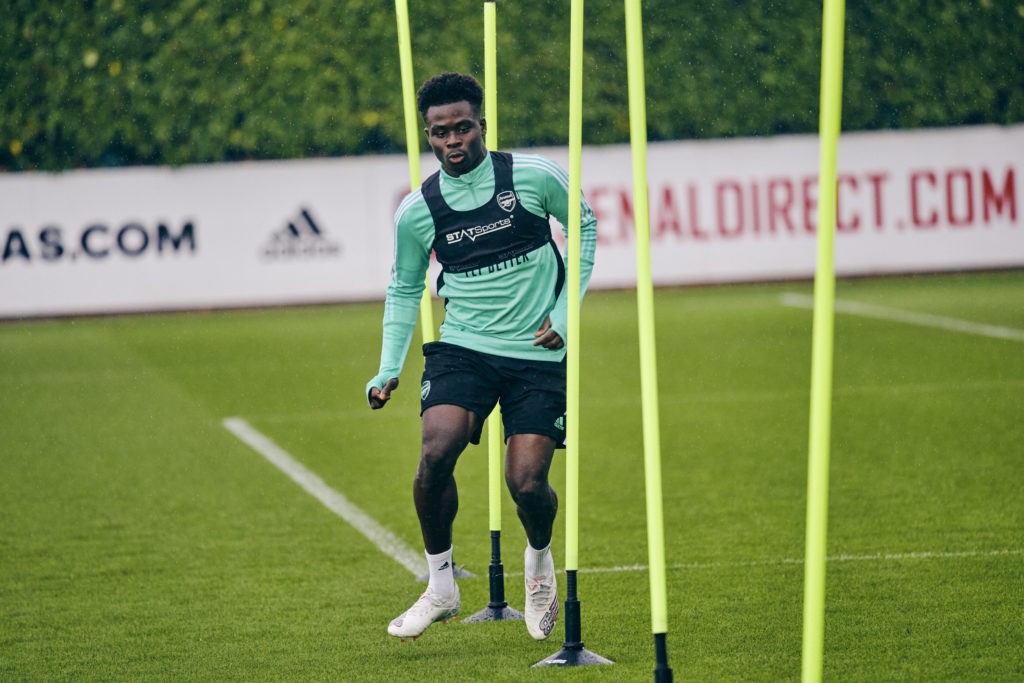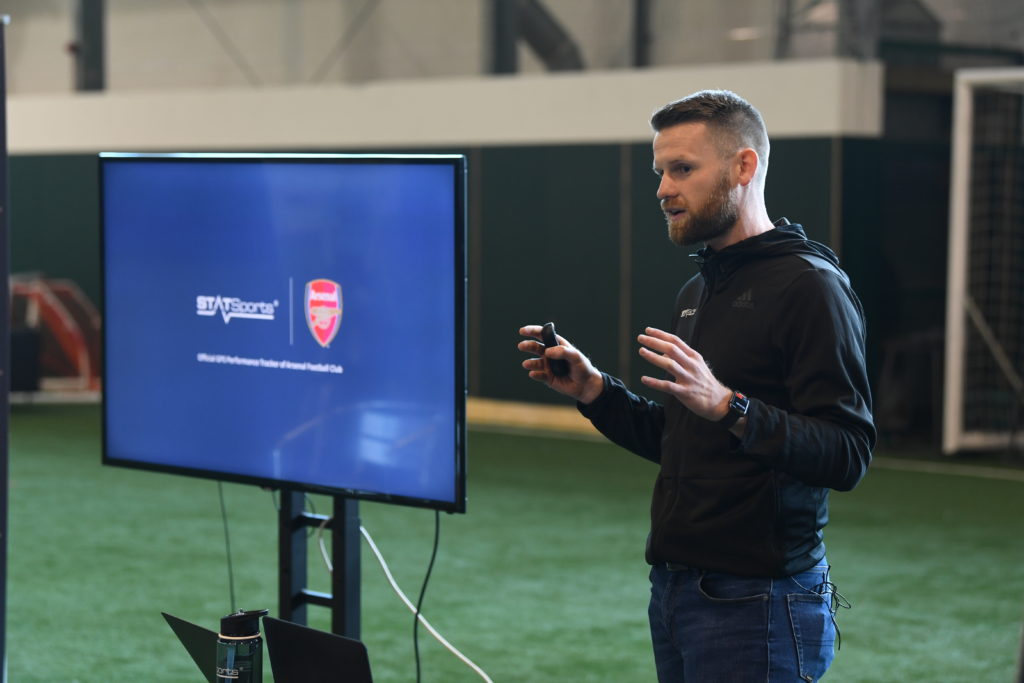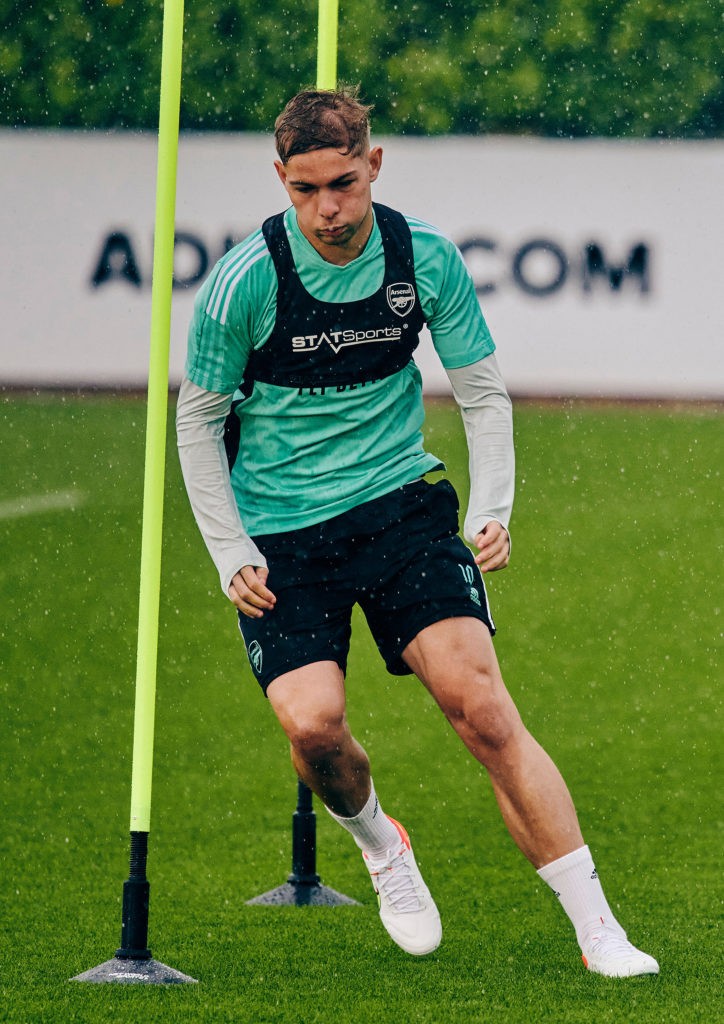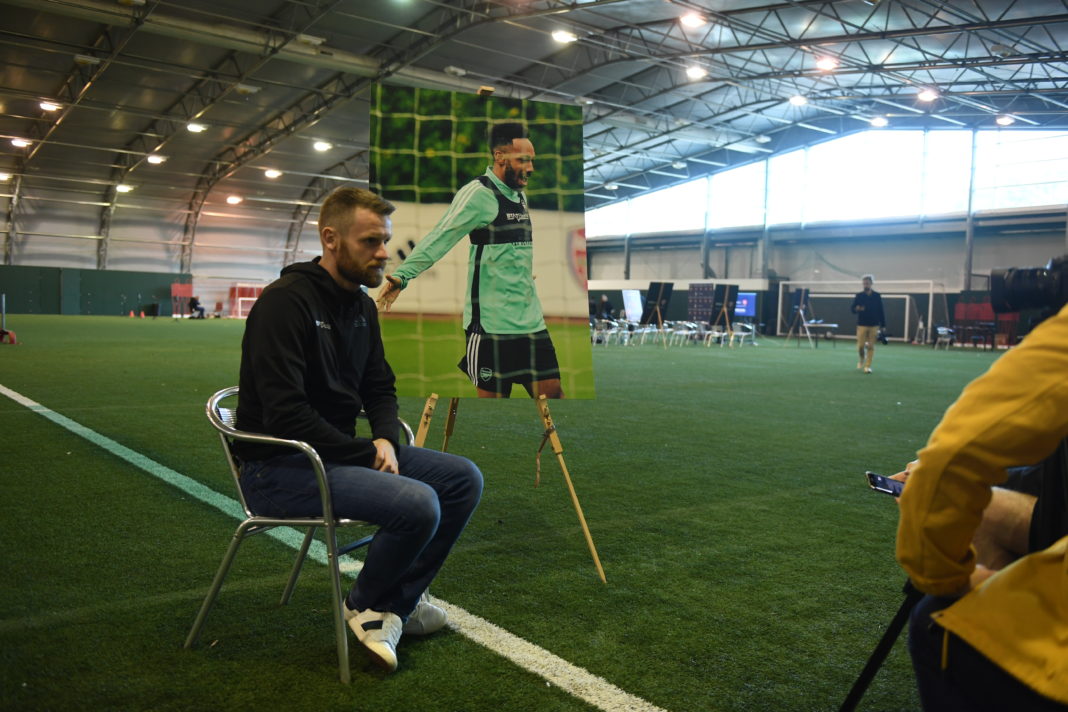Earlier this week, we had a chance to speak to STATSports’ Barry Watters about their new partnership with Arsenal.

Arsenal recently announced their new partnership with STATSports, a GPS data company.
You’ve probably already seen the Arsenal players wearing the black vests (as pictured above), but the new partnership sees STATSports become the official GPS Performance Tracker of Arsenal and will allow members of the public to access some of the data.
Aspiring players will be able to purchase one of the vests and trackers, then track and review their own data, as well as compare it against Arsenal first-team men, women, and academy players.
This data includes distances covered, maximum speeds, intensity, fatigue levels, and so on.
Arseblog’s Tim Stillman and I had the chance to speak to STATSports Head of Sport Science Barry Watters about the partnership this week.
We talked about the impact and challenges of the pandemic, how the fitness advice they give varies for younger and older players, and the current hot topic of intellectual property – what with Arsenal players having their data made available to the public.
Read on for all that and more…
Q: I think there are two things really missing from football coverage. One is proper analysis of goalkeeping, which just doesn’t happen, the other is proper data on the physical side.
Do you see this product as potentially breaking down a barrier in understanding the demands and how good these players actually are?
A: I think when you see any data in relation to games it’s usually like the ‘total distance covered by the team’. So I think what this will allow the fans to do is contextualise how you get to that distance.
It’s fair enough if you do 10k in a game, but it’s all about how you actually achieve that 10k. So we’re talking about sprint efforts, high-speed running, max speeds achieved, high-intensity distance.
It’ll allow the fans that use this application to be able to appreciate a little bit more just how good physically these guys are as well. I think as fans we make a lot of judgements based on results and whether the performance goes the way we want it to go.
You’ll be able to see per position as well, so if you’re a left-back the demands are different than if you’re a central midfielder. Anyone in a winger position – a lot of high-speed running up and down the field, central midfield – a lot of pressing the ball, decelerating, pressing the ball, decelerating, so a lot of short, sharp movements.
It’ll give the fans some insight into all of that and maybe how close or far off they might be as well.
[On] broadcasters as well, eventually, it will get there, at the minute there’s a lot of tactical analysis which everyone loves as well. But the data will start to come in.
Earlier, I mentioned a ‘physical skill set’. We always talk about a ‘tactical skill set’ and I like to refer to it as a ‘physical skill set’ because if you’re playing in a system where the manager needs you to be doing really high pressing, that high intensity, you need to be physically able to perform those metres. You might be able to do it once, and then you get caught out in behind, but these guys need to be able to do it over and over again.
The goalkeeper stuff, I think there’s probably not enough goalkeepers in the world for that analysis to be done! But in our elite product, we actually have goalkeeper-specific metrics as well – like the number of dives left and right, time to feet, all that kind of stuff. The elite clubs would use that sort of context for physical aspects as well.

Q: STATSports has been going since 2008, so with the perspective you’ve gained in that time, how has the pandemic affected the stats and data collection?
A: What was probably the most challenging during the pandemic was that all the players had to isolate and train on their own, which was a great chance for our product as well, to be used by the individual players to monitor training.
If you and I go out and do a run we’ll maybe do a 5k, but for these guys, that’s not the training they need. They need to be able to do short, sharp, high-intensity stuff. So we’re measuring things like accelerations, decelerations, sprints, max speed, and that data was able to be measured by a consumer device, and then reported back to the Arsenal performance staff as well.
They make some leaderboards, and make it a little bit gamified as well, so the guys can compete against each other. They all love seeing who’s the quickest and everything.
Then the other challenge after, for all teams, is fixture congestion as well. After coming from a period where you haven’t really been able to train as a team, we’re gonna have lots of games in a short period of time.
So what’s really important during that is the recovery. When you use this data you can decide based on the data ‘okay, tomorrow, taper down and have a recovery session’. You can also give advice on nutrition as well, what they need to do to recover.
And obviously at the professional level these guys have performance staff that are helping them out with that all the time. But recovering is the biggest thing, and I think that’s maybe a misconception about this sort of technology, that it’s there to catch players out. But it’s the other thing, it’s there to help these guys make sure they’re ready to perform and ultimately prepared to perform in the games.
So that was the challenge for the performance staff, just trying to get the guys prepared enough for the outputs that came as well.
I think even with the games they were probably a little less intense without the fans when things came back. But as it built up you could see that the games were getting better and better and more intense as well.
Over the last 10 years, the game has completely changed. The total distance is the same, but the amount of high-speed running these guys do now is incredible during games. That’s what they need to be able to do week-in, week-out.
Q: With STATSports making this data available to the public, are there any challenges around intellectual property?
A: Yeah, I think globally there’s obviously challenges around data protection, GDPR. From STATSports’ point of view, we meet ISO certification for data protection to make sure that everything that’s shared is meant to be shared, or anything that’s anonymised is meant to be anonymised.
So with this agreement that would’ve went through Arsenal, as the club, who would then talk to the players as well about what actually gets shared, and you can see from some of the cards here, it’s like their personal bests, their pro score based on those metrics as well.
It’s something that pops up, but from our point of view, we deal directly with the clubs and then the clubs deal with all the IP aspects regarding their players.

Q: How does the data collected and the advice given vary between players in the younger and older age groups?
A: As a young player, it’s more about education, rather than around what physical attributes they need to be able to perform. I suppose as you’re a young player, 12 or 13, you’ve got loads of chances to mature and grow, there are loads of late developers as well.
What it gives you a chance to do is sort of benchmark your data, see where you’re at now, and then progress throughout time. A lot of the Arsenal guys that have come through the academy process used the devices throughout as well.
Whereas with the older players it might be more about recovery, making sure that they’re doing optimal amounts, because there’s diminishing returns. You’re not going to make a player who’s 35 two or three times quicker than they already are.
You want to try and control the load and make sure the volumes that they do in training are correct and try to match the game intensity so that they’re fully prepared for the game. When you’re talking about three or four day turnarounds it’s all about recovery, making sure they’re in the best possible shape to go again.
It depends, but it usually differs like that, and then by style as well. So if you play a high press, then what we do in training will be different than if we’re a possession-based team, because we’re hopefully going to keep the ball a lot longer and not be chasing after it.
You’ll see the different teams throughout the Premier League as well, using those different styles, and they’ll look for players with those physical skill sets to perform in those positions as well.
Q: The age curve of footballers actually hasn’t changed that much, they’re still retiring at similar ages, peak years are still considered the same, roughly.
Do you see data like this being able to change that at all, or are the demands becoming so big that it cancels out?
A: Yeah, I think that’s probably what’s cancelling that out. It’s that as the time has gone, the demands of the game have got much higher as well. But I think longevity of a career is multi-faceted, there’s lots of aspects outside of just the data – lifestyle, how they live outside, and recovery and everything they do to make sure they’re in the best possible shape.
But I think this data does help, and that’s the biggest change we’ve seen with older players who maybe thought that this data could be detrimental to their career, because it’s showing that they’re slowing down or whatever. It’s quite the opposite.
We’re trying to use this data to protect them, make sure they get the right recovery, and if there’s areas we need to work on, that they can work on it. These players now love this data, because it reaffirms everything as well, that they’re able to compete at that level.
Injury avoidance is what you want to achieve as well. Injury prevention is really hard because there’s a lot of things that goes into it, but having this data as well, along with everything else – like sleep and stress and everything that happens outside of football – we can bring it all together and paint a better picture of the athlete or make sure you give them every chance to perform.
Q: Are there any data sets you aren’t currently covering that you might look to move into in the future?
A: At the minute, we cover a lot of field-based sports throughout the world. Within our application you get the physical metrics and you get the cardiovascular metrics as well.
Obviously Arsenal have performance staff, what we’re trying to do is bring the application to be like a sport scientist, so it’s intuitive and can give you feedback based on the data that you achieve in a session. Also by knowing when your next game is, or when you’re playing next, we can give some advice on the type of training that you maybe should do as well.
With the world of technology, things move pretty quickly, so I’m sure there will be something else as well in the near future.
Q: Do you sense that particularly with guys in that 20-30 sphere that there’s a massive appetite for something like this? And again looking at gamification, how do you think things like FIFA have played into that?
A: I think anything that you watch on TV now has some sort of data within it and from our point of view we can see even from the grass-roots level, all the way up from under-13, there’s a want for this data, to be able to measure and improve.
And especially in that bracket of 20-30, as you say, the whole gamification aspect of it is being able to see some aspects within the app where you have to complete X number of sessions before you unlock a feature and before you get your pro score so you can compare yourself to the Arsenal first-team players of choice.
But more importantly, it’s at that grass-roots level for us, where there’s a young aspiring Gunner who wants to play in a certain position. They can compare themselves against the actual academy players within Arsenal, male or female, to see exactly what physical attributes are required to compete at that level.

Q: There’s mention of the use of AI in the press release. Can you explain what that’s used for?
A: Yeah, so the AI in the background would have a lot of inputs put into it, the 16 metrics that go into it.
This is the thing, everyone is different depending on position, age, running ability or running style. So what we have in the background is able to track your data and trends, so you can see yourself over a week, month, year, so you can see the data.
But where we want to bring in the AI is to be more prescriptive, to tell you: In three days you’ve got a game, typically you do this much, so we want you to recover, or we want you to do X amount of sprints in the buildup.
For the fan, it’s fine giving them the numbers. But when they get the numbers they may not know if that’s good, if that’s bad, and that’s what we’re trying to layer on top here. So it gives some insight into what you should do next based on those numbers and how to continually improve.
And that’s where we want to get to, content on how to improve max speed, how to improve acceleration, how to improve high-speed running. Give the kids and end users some drills and some ideas of how to actually do that as well. So it’s not just ‘here’s the data, figure it out yourself’, it’s more like we’re giving the insights and hopefully pushing these guys on.
Hopefully, someday, with this partnership, there is someone that’s noticed from a physical skill set point of view and they also have the tactical skill set to match that to be able to commit to the Arsenal academy.
Q: This is a really developing area in the women’s game. In marketing this product to the public, what level of research was done into women’s and girl’s football?
A: We work with a lot of international women’s teams, and a lot of women’s teams in the Premier League as well.
From a broadcast point of view it’s got more airtime and everything now, but I think they’ve been doing the right things for a number of years now. They’ve been training professionally, using the equipment to monitor and measure, and obviously the outputs are different due to physical attributes.
We worked with the U.S. Women’s National Team a lot, with Dawn Scott who was there and is now in the English FA. There’s a lot of work going in there and thankfully, we’re embedded throughout the FA as well across all the women’s and men’s teams and that’s what we have here at Arsenal as well.
That’s what you want, because you want to be able to see that progression as well, and see it pair to the sport that they’re actually playing and what the demands are for that game. They will differ between the men’s and the women’s games as well.
I think it’s a really interesting area, there’s a lot of injury prevention stuff that can be done in the women’s game as well. There’s a lot more ACL injuries that happen in the women’s game. As a sports scientist working on that, it’s really, really interesting, and it’s a big area where a difference can be made to protect the players a little bit more.
Q: Are there any other applications for the vests and GPS trackers?
A: On the elite side of things, we use some machine learning to auto-detect shape, so you can see the shape that the team is in – because obviously GPS has got location data.
I don’t know if it would be good enough for VAR, calling offsides, that might be tricky and not something we might want to get into!
But I think formations and the way we’d look at that is by what’s a successful formation. If you think of a team, when they’re defending they’re quite dense, they get close together, when they’re attacking you want that to be quite widespread.
We can see that, see what ‘good’ looks like, so if you concede a goal, you might be able to see that ‘we were out of shape here’. It comes into that physical skill set as well, you can see through the location what the players should be able to cover.
If they’re physically prepared, they should be able to cover that space, even if someone comes into it. So that’s where these numbers come into importance.
The new STATSports Arsenal FC Edition is available from the 18th October at www.statsports.com/arsenal

